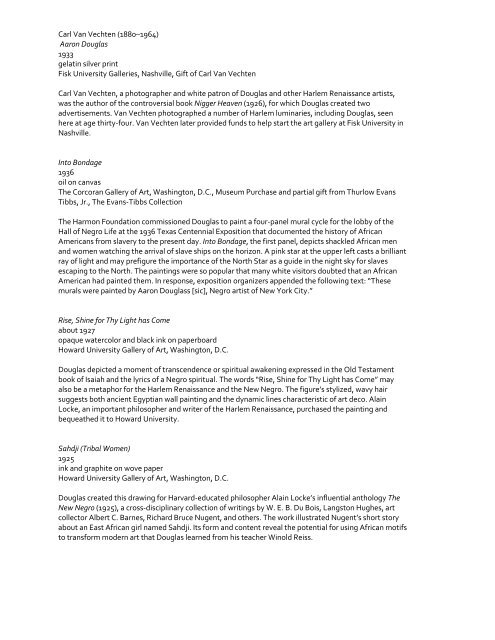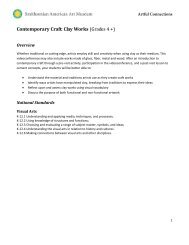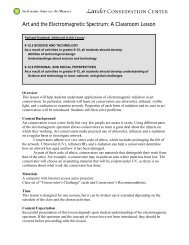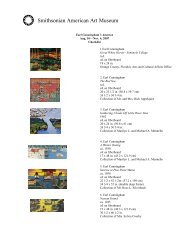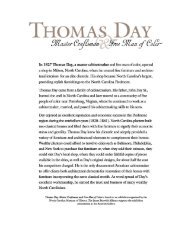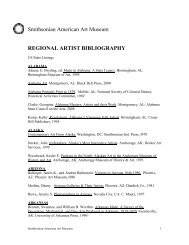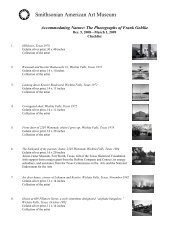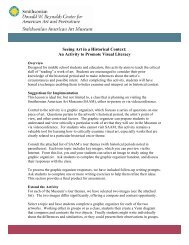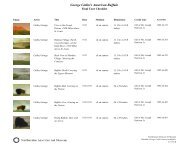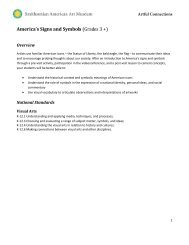Smithsonian American Art Museum Wall Text & Extended Labels
Smithsonian American Art Museum Wall Text & Extended Labels
Smithsonian American Art Museum Wall Text & Extended Labels
You also want an ePaper? Increase the reach of your titles
YUMPU automatically turns print PDFs into web optimized ePapers that Google loves.
Carl Van Vechten (1880–1964)<br />
Aaron Douglas<br />
1933<br />
gelatin silver print<br />
Fisk University Galleries, Nashville, Gift of Carl Van Vechten<br />
Carl Van Vechten, a photographer and white patron of Douglas and other Harlem Renaissance artists,<br />
was the author of the controversial book Nigger Heaven (1926), for which Douglas created two<br />
advertisements. Van Vechten photographed a number of Harlem luminaries, including Douglas, seen<br />
here at age thirty‐four. Van Vechten later provided funds to help start the art gallery at Fisk University in<br />
Nashville.<br />
Into Bondage<br />
1936<br />
oil on canvas<br />
The Corcoran Gallery of <strong>Art</strong>, Washington, D.C., <strong>Museum</strong> Purchase and partial gift from Thurlow Evans<br />
Tibbs, Jr., The Evans‐Tibbs Collection<br />
The Harmon Foundation commissioned Douglas to paint a four‐panel mural cycle for the lobby of the<br />
Hall of Negro Life at the 1936 Texas Centennial Exposition that documented the history of African<br />
<strong>American</strong>s from slavery to the present day. Into Bondage, the first panel, depicts shackled African men<br />
and women watching the arrival of slave ships on the horizon. A pink star at the upper left casts a brilliant<br />
ray of light and may prefigure the importance of the North Star as a guide in the night sky for slaves<br />
escaping to the North. The paintings were so popular that many white visitors doubted that an African<br />
<strong>American</strong> had painted them. In response, exposition organizers appended the following text: “These<br />
murals were painted by Aaron Douglass [sic], Negro artist of New York City.”<br />
Rise, Shine for Thy Light has Come<br />
about 1927<br />
opaque watercolor and black ink on paperboard<br />
Howard University Gallery of <strong>Art</strong>, Washington, D.C.<br />
Douglas depicted a moment of transcendence or spiritual awakening expressed in the Old Testament<br />
book of Isaiah and the lyrics of a Negro spiritual. The words “Rise, Shine for Thy Light has Come” may<br />
also be a metaphor for the Harlem Renaissance and the New Negro. The figure’s stylized, wavy hair<br />
suggests both ancient Egyptian wall painting and the dynamic lines characteristic of art deco. Alain<br />
Locke, an important philosopher and writer of the Harlem Renaissance, purchased the painting and<br />
bequeathed it to Howard University.<br />
Sahdji (Tribal Women)<br />
1925<br />
ink and graphite on wove paper<br />
Howard University Gallery of <strong>Art</strong>, Washington, D.C.<br />
Douglas created this drawing for Harvard‐educated philosopher Alain Locke’s influential anthology The<br />
New Negro (1925), a cross‐disciplinary collection of writings by W. E. B. Du Bois, Langston Hughes, art<br />
collector Albert C. Barnes, Richard Bruce Nugent, and others. The work illustrated Nugent’s short story<br />
about an East African girl named Sahdji. Its form and content reveal the potential for using African motifs<br />
to transform modern art that Douglas learned from his teacher Winold Reiss.


